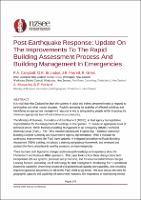Post-Earthquake Response: Update on the Improvements to the Rapid Building Assessment Process and Building Management In Emergencies

Download
Date
2024-04-09Authors
Campbell, Paul
Brunsdon, Dave
Farrell, Jeff
Macauley, Amanda
Herbert, Eddie
Green, Rori
Metadata
Show full item recordAbstract
It is vital that New Zealand has both the systems in place and trained personnel ready to respond to earthquakes and other natural disasters. Rapidly assessing the usability of affected buildings and identifying an appropriate management response is key to safeguarding people whilst imposing the minimum appropriate level of restrictions on a community.
The Ministry of Business, Innovation and Employment (MBIE), as lead agency has legislative responsibilities for the management of buildings in emergencies. To ensure an appropriate level of technical advice, MBIE formed a Building Management in an Emergency (BMIE) Technical Working Group (TWG). The TWG membership includes Engineering, Territorial Authority/ Building Consent Authority and Government Agency representation. With a mandate for continuous improvement, the TWG have updated, re-instigated and delivered Rapid Building Assessment (RBA) training, introduced a training competency framework, and reviewed and updated the forms and placards used by assessors during emergencies.
There has been both legislative changes and increased knowledge and experience since the Christchurch and Kaikoura RBA operations. This paper looks at how these changes have been incorporated into our systems, processes and procedures, and the rationale behind those changes. Looking forward, increasing use of technology for data management, developing Tier 1 leadership capability, improving structural and geotechnical capacity and capability, and providing improved guidance documents are all on the TWG work programme. We also discuss the need for geographic capacity and capability of assessment resources, the importance of maintaining mental wellbeing of assessors as a core component of successful deployment, as well as the latest international thinking around cordon management.
